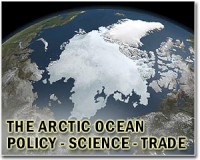| . |  |
. |
Oslo, Norway (UPI) May 5, 2011 Arctic warming, occurring twice as fast as the global average, could raise sea levels more than 5 feet in 90 years, an official multinational study forecast. The Arctic Monitoring and Assessment Program forecast -- for the international Arctic Council of eight arctic rim countries, including the United States -- predicted sea levels would rise 2.75 times more than the top figure of the landmark 2007 U.N. Intergovernmental Panel on Climate Change, which forecast of 7 to 23 inches by the end of the century. "Global sea level is projected to rise 0.9 to 1.6 meters [3 feet to 5 feet 3 inches] by 2100, and the loss from arctic glaciers, ice caps and the Greenland Ice Sheet will make a substantial contribution to this," the AMAP report said ahead of a May 12 meeting in Greenland of Arctic Council nations Canada, Denmark, Finland, Iceland, Norway, Russia, Sweden and the United States. AMAP is a council working group. The Greenland Ice Sheet is the second-largest body of ice after the Antarctic Ice Sheet covering more than 660,000 square miles, or roughly 80 percent of Greenland. If it were to melt totally, its frozen water would push up global sea levels 24 feet, a 2001 study indicated. The reason for the accelerated melting and seal-level rise is a phenomenon, or mechanism, called "feedbacks," the study said. When ice melts, sunlight energy is absorbed rather than reflected because the ocean is darker than white ice. A warmer ocean warms surface air temperatures, which leads to more ice melting, which makes more ocean available to absorb heat. "A number of other potential feedback mechanisms at play in the Arctic have been identified," the study said. "These mechanisms can alter the rate or even direction of climate change and associated changes in the cryosphere," referring to frozen land and sea. "The greatest increase in surface air temperature has happened in autumn, in regions where sea ice has disappeared by the end of summer," the study said. "This suggests that the sea is absorbing more of the sun's energy during the summer because of the loss of ice cover. The extra energy is being released as heat in autumn, further warming the Arctic lower atmosphere." On land, "early snow melt is accelerated by earlier and stronger warming of land surfaces that are no longer snow-covered," the study said.
Share This Article With Planet Earth
Related Links Beyond the Ice Age
 Nuclear leak forces Russian icebreaker back to port
Nuclear leak forces Russian icebreaker back to portMoscow (AFP) May 5, 2011 Russia launched an urgent rescue mission on Thursday after one of its atomic-powered icebreakers developed a nuclear leak in the frozen seas of the Arctic and was forced to abandon its mission. The Rosatomflot nuclear fleet said in a statement that an "insignificant increase in activity" had been detected on board its 21,000-tonne Taimyr icebreaker. But the incident was serious enough to ... read more |
|
| The content herein, unless otherwise known to be public domain, are Copyright 1995-2010 - SpaceDaily. AFP and UPI Wire Stories are copyright Agence France-Presse and United Press International. ESA Portal Reports are copyright European Space Agency. All NASA sourced material is public domain. Additional copyrights may apply in whole or part to other bona fide parties. Advertising does not imply endorsement,agreement or approval of any opinions, statements or information provided by SpaceDaily on any Web page published or hosted by SpaceDaily. Privacy Statement |